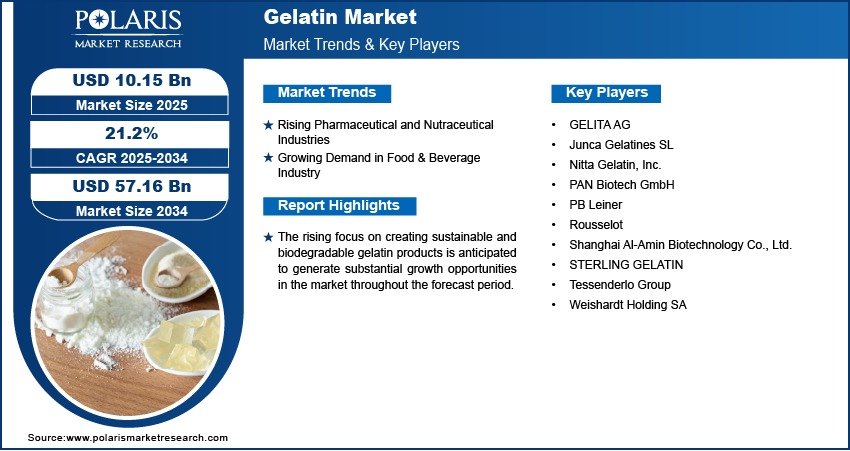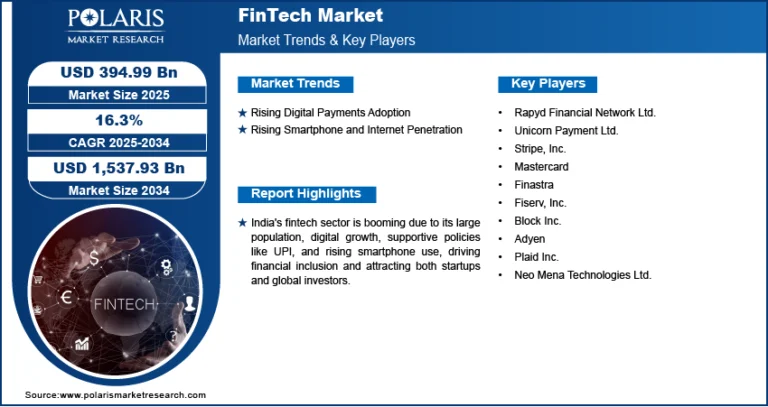Gelatin Market Overview: Growth Trends and Future Outlook

The global gelatin market is witnessing significant growth due to rising demand across the food, pharmaceutical, cosmetic, and biomedical industries. Gelatin, a protein derived mainly from animal collagen, offers excellent gelling, stabilizing, and thickening properties, making it a valuable ingredient in a wide variety of applications. Market growth is driven by increasing consumer preference for protein-rich diets, the surge in demand for functional foods and dietary supplements, and innovations in pharmaceutical capsule manufacturing. The global gelatin market size is expected to reach USD 57.16 billion by 2034, according to a new study by Polaris Market Research.
Market Dynamics
The gelatin market has been expanding steadily and is projected to continue growing at a healthy compound annual growth rate (CAGR) over the next decade. One of the major factors contributing to this growth is the increased consumption of convenience and processed foods, which often incorporate gelatin for its texture-enhancing and stabilizing capabilities. Moreover, the rise in health consciousness among consumers has led to increased intake of collagen supplements, further fueling gelatin demand.
In the pharmaceutical sector, gelatin plays a critical role in the production of hard and soft capsules, tablets, and wound care products. Its biocompatibility and ability to form hydrogels make it suitable for controlled drug delivery and regenerative medicine applications. In the cosmetics industry, gelatin is used in skin care products for its film-forming and moisturizing properties.
Segmentation Insights
The gelatin market is segmented by source, type, function, and application. Based on source, animal-based gelatin dominates the market, particularly those derived from pig skin, bovine hides, and bones. However, due to growing consumer concerns regarding animal welfare, dietary restrictions, and religious considerations, the demand for alternative sources such as fish and plant-based gelatin substitutes is on the rise.
In terms of type, Type A gelatin (derived from acid-treated raw materials) is more widely used in food products, while Type B (from alkaline-treated materials) is preferred in pharmaceutical applications. Functionally, gelatin serves as a gelling agent, stabilizer, thickener, and emulsifier, with applications varying across food, beverages, personal care, and biomedical products.
Regional Analysis
Regionally, Europe and North America hold significant shares in the global gelatin market due to their established food and pharmaceutical industries. However, the Asia-Pacific region is emerging as the fastest-growing market, driven by rising disposable incomes, expanding healthcare infrastructure, and a growing population seeking nutritional and cosmetic products. Countries like China and India are becoming major markets for both consumption and production of gelatin.
Key Market Trends
-
Rise of Clean-Label and Halal/Kosher Products: Consumers are increasingly demanding gelatin products that are clean-label and compliant with religious dietary laws.
-
Growing Popularity of Collagen Supplements: The global wellness trend is boosting sales of collagen peptides and gelatin-based nutritional products aimed at improving joint and skin health.
-
Technological Advancements: New processing methods are being developed to improve gelatin extraction efficiency, product quality, and environmental sustainability.
-
Emerging Biomedical Applications: Gelatin is being explored for use in advanced medical applications such as wound healing, tissue engineering, and bio-inks for 3D bioprinting.
Future Outlook
The gelatin market is poised for strong growth in the coming years as innovation, health trends, and sustainability concerns shape its future trajectory. While traditional animal-based gelatin will continue to dominate, the market is expected to witness increased diversification with the introduction of alternative sources and high-value applications. Companies investing in ethical sourcing, product transparency, and advanced research are likely to gain a competitive edge in this evolving market.






